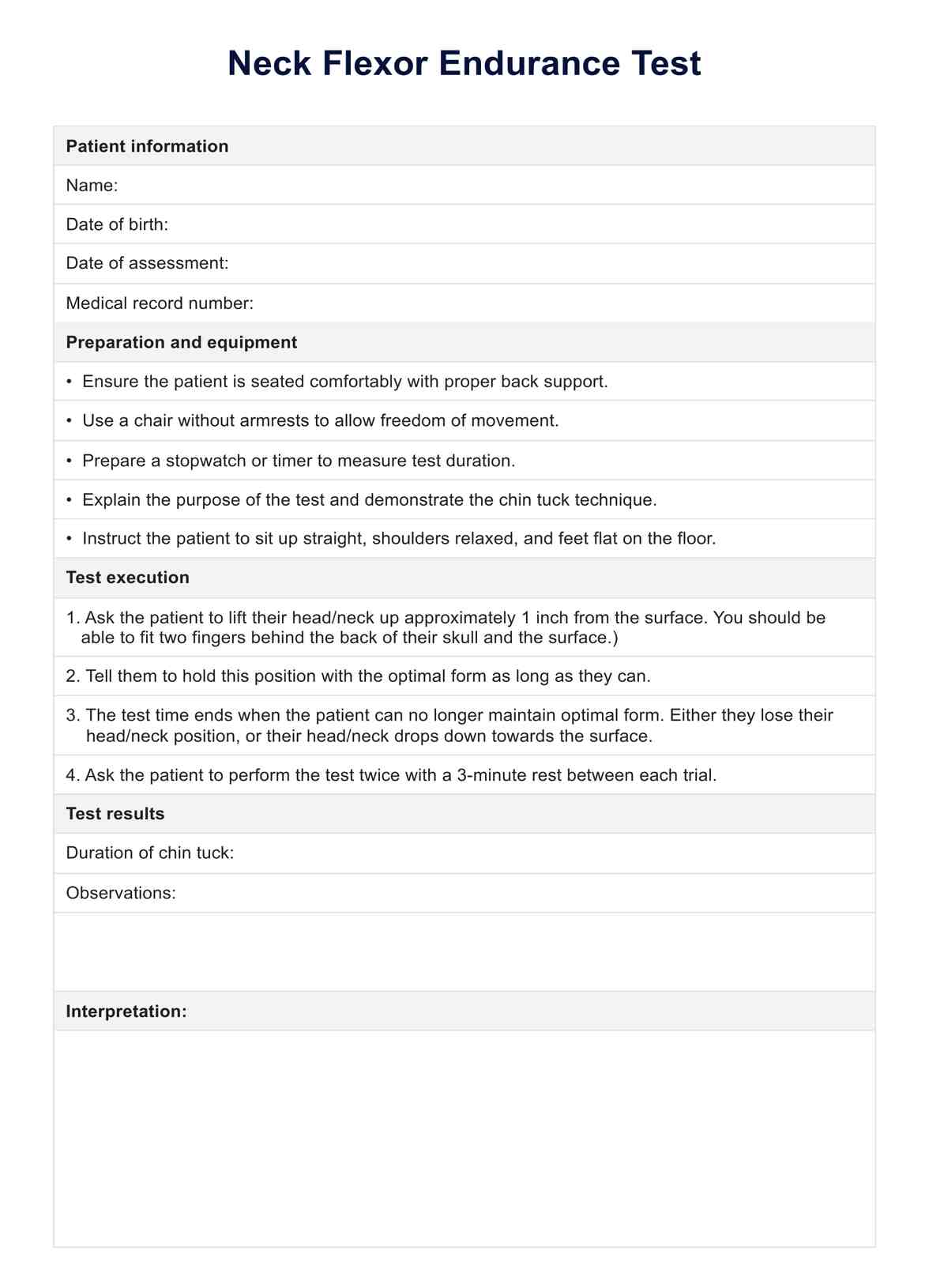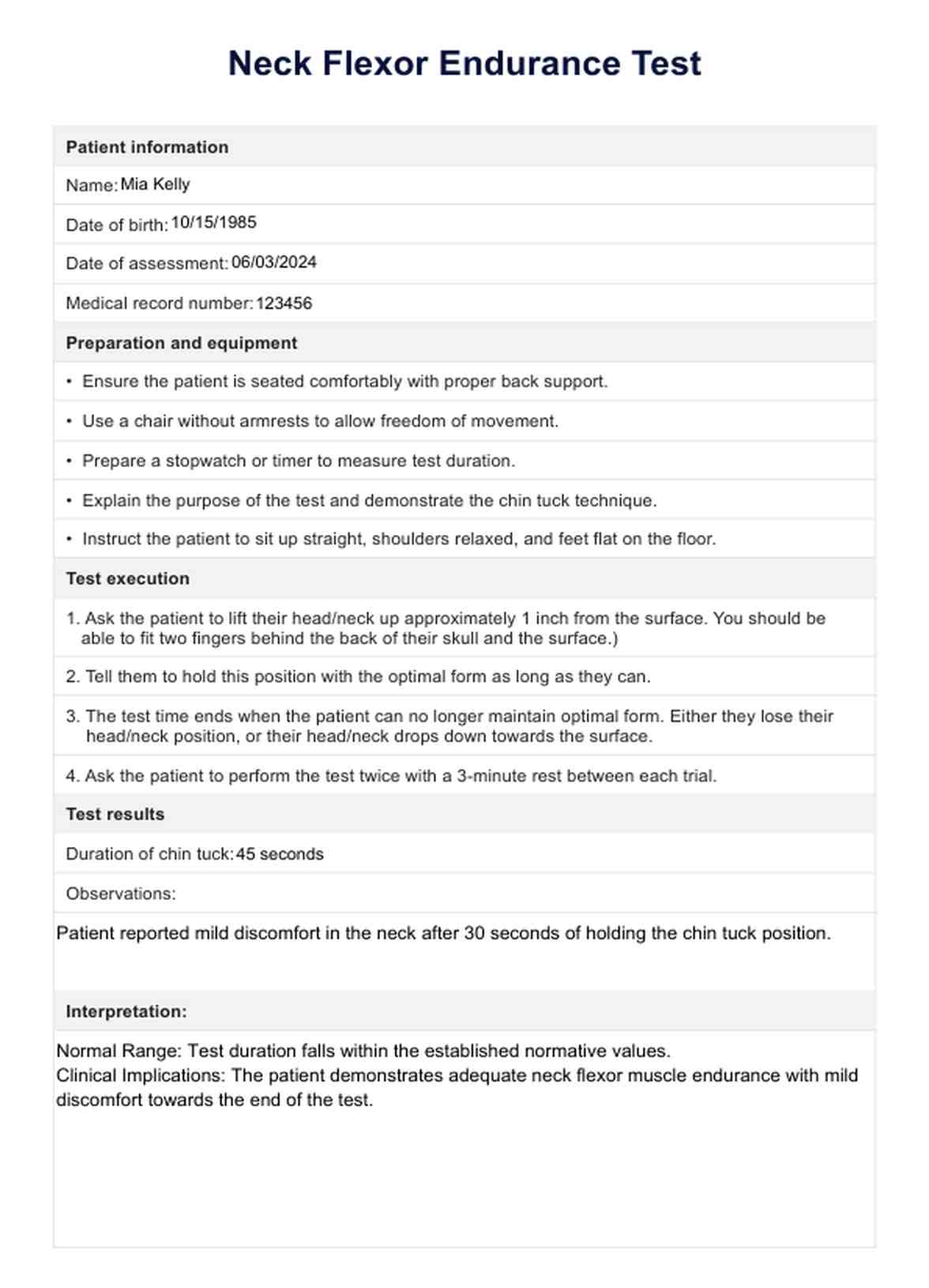Neck Flexor Endurance Test
Learn about the Neck Flexor Endurance Test, including how it is conducted and what it measures. Download Carepatron's free PDF example to see how this test is performed.


What is the Neck Flexor Endurance Test?
The Neck Flexor Endurance Test is a clinical assessment used to evaluate the endurance and strength of the deep cervical flexor muscles in the neck. These muscles, known as the deep neck flexors, play a crucial role in stabilizing the cervical spine and supporting posture.
During the test, the individual is instructed to perform a chin tuck, activating the deep neck flexors while maintaining the natural curvature of the cervical spine. This action helps isolate the deep cervical flexors, including the longus colli and longus capitis muscles, from the larger superficial neck muscles.
The Neck Flexor Endurance Test is particularly useful in assessing individuals with neck pain or cervical spine pain, as it can identify muscle dysfunction and weakness in the deep neck flexors. Weakness in these muscles is often associated with poor posture, cervical spine instability, and increased risk of neck injuries.
Healthcare practitioners may recommend the Neck Flexor Endurance Test for patients experiencing chronic neck pain or those undergoing rehabilitation for cervical spine injuries. By assessing neck flexor muscle endurance, practitioners can develop targeted treatment plans to improve posture, alleviate neck pain, and restore function to the cervical and upper thoracic spine.
Neck Flexor Endurance Test Template
Neck Flexor Endurance Test Example
How to perform the Neck Flexor Endurance Test
The Neck Flexor Endurance Test is a straightforward clinical assessment that can be easily performed by healthcare practitioners to evaluate the endurance and strength of the deep cervical flexor muscles. Below are the steps to conduct the test effectively:
Step 1: Preparation and equipment
Ensure the individual is seated comfortably upright with proper back support. Have a chair without armrests to allow freedom of movement. A stopwatch or timer is needed to measure the duration of the test. Carepatron's Neck Flexor Endurance Test template can be downloaded from the Carepatron website or accessed through their mobile app for convenient documentation.
Step 2: Instruction to the individual
Explain the purpose of the test and the desired chin tuck movement. Instruct the individual to sit up straight with shoulders relaxed and feet flat on the floor. Demonstrate the proper chin tuck technique: gently retract the chin, bringing it towards the neck without tilting the head up or down.
Step 3: Test execution
Instruct the individual to perform a chin tuck and hold the position for as long as possible. Start the timer as soon as the chin tuck is initiated. Encourage the individual to maintain the chin tuck position without straining or discomfort. Monitor the individual closely for compensatory movements or deviations from the proper technique.
Step 4: Test termination
End the test when the individual can no longer maintain the chin tuck position or reports significant discomfort. Use the stopwatch to record the duration of the test in seconds.
Step 5: Interpretation and documentation
Evaluate the test results and interpret your findings. Document the test findings, including the duration of the chin tuck held, any observations of compensatory movements, and any reported discomfort or pain. Use Carepatron's template to input the test results and generate comprehensive reports for patient records.
Results and Interpretation of the Neck Flexor Endurance Test
The Neck Flexor Endurance Test results provide valuable insights into the strength and endurance of the cervical flexor muscles, aiding in the assessment of neck pain and cervical spine stability. Interpretation of the test results is crucial for guiding treatment interventions effectively.
Positive result
A positive Neck Flexor Endurance Test result indicates good muscle endurance and strength in the deep cervical flexors. This is characterized by the individual's ability to maintain the chin tuck position for a prolonged duration without significant discomfort or fatigue. Positive results suggest the optimal function of the deep neck flexors and are typically observed in individuals with good posture and neck muscle health.
Negative result
Conversely, a negative result suggests weakness or dysfunction in the cervical flexor muscles. This is indicated by the individual's inability to sustain the chin tuck position for an extended period or experiencing discomfort or fatigue relatively quickly during the test. Negative results may be associated with neck pain, poor posture, cervical spine instability, or muscle imbalances.
Interpretation
Here's how to interpret the results of the Neck Flexor Endurance Test:
- Normal range: Test durations falling within established normative values indicate adequate neck flexor muscle endurance and are considered normal.
- Below normal: Test durations below the established normative values suggest decreased neck flexor muscle endurance and may indicate muscle weakness or dysfunction.
- Above normal: Test durations exceeding normative values may suggest superior muscle endurance, but clinicians should assess for compensatory movements or other factors influencing the results.
What are the next steps?
After performing the Neck Flexor Endurance Test and interpreting the results, the next steps involve developing a targeted treatment plan based on the findings. For individuals with positive results indicating good muscle endurance, emphasis may be placed on maintaining proper posture and neck muscle health through exercises and lifestyle modifications.
Conversely, individuals with negative results may require interventions focused on strengthening the cervical flexor muscles, improving posture, and addressing underlying issues contributing to muscle weakness or dysfunction.
Regular reassessment of neck flexor muscle endurance and progress monitoring are essential to track improvement and adjust treatment as needed.
Benefits of using our template
Our Neck Flexor Endurance Test template offers several advantages for healthcare practitioners in clinical settings and physical therapy practices. Here are the key benefits:
Streamlined documentation
Our template simplifies the documentation process by providing a structured format for recording test results, observations, and patient information. Practitioners can easily input data and generate comprehensive reports, saving time and ensuring accurate deep neck flexor endurance assessment documentation.
Enhanced accuracy
By utilizing our template, practitioners can ensure consistent administration and interpretation of the Neck Flexor Endurance Test, minimizing variability and improving the reliability of results. Accurate documentation facilitates more precise tracking of neck flexor muscle endurance changes over time, aiding in treatment planning and evaluation.
Customizable features
Our template is customizable to accommodate individual patient needs and specific clinical requirements. Practitioners can tailor the template to include additional fields for relevant anthropometric measurements, connective tissue disorders, or other factors influencing neck pain and muscle endurance.
Facilitates monitoring and progress tracking
The template facilitates ongoing neck flexor muscle endurance monitoring and allows practitioners to track patient progress throughout treatment. Regular documentation enables practitioners to identify trends, assess treatment effectiveness, and make informed adjustments to intervention plans as needed.
Integration with carepatron platform
Our template seamlessly integrates with the Carepatron platform, providing access to additional features such as scheduling, billing, and telehealth services. By leveraging the comprehensive capabilities of the Carepatron platform, practitioners can streamline workflow management and enhance patient care coordination.
Commonly asked questions
The neck flexor muscle endurance test is a clinical assessment used to evaluate the endurance and strength of the deep cervical flexor muscles. This clinical test involves maintaining a chin tuck position for as long as possible to assess muscle endurance.
A positive Cervical Flexion Rotation Test indicates dysfunction or instability in the upper cervical spine. It is characterized by the inability to maintain cervical rotation while performing a chin tuck, suggesting potential cervical spine pathology.
Deep neck flexor strength can be measured using manual muscle testing or specialized equipment such as a dynamometer. It involves assessing the force generated by the deep cervical flexor muscles during specific movements or resistive tasks.







































































































